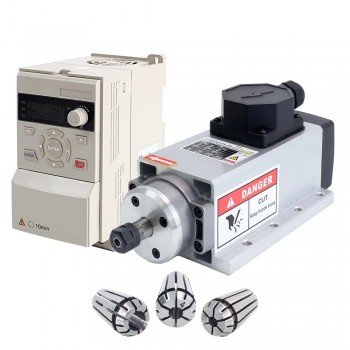1. Brief definition of CNC spindle motors
CNC spindle motors are motors used to drive the spindle in mechanical equipment to rotate, usually by driving a belt or directly connecting the spindle to achieve mechanical movement. CNC spindle motors are efficient, stable and reliable, and are widely used in mechanical processing, CNC machine tools and other equipment that require high-speed rotation.

2. Control methods of CNC spindle motors
The control of spindle motors usually includes open-loop control and closed-loop control. Open-loop control is simple and low-cost, but has low accuracy; while closed-loop control provides higher control accuracy through real-time monitoring and correction through position and speed feedback systems (such as encoders). Closed-loop control systems can monitor the position and speed of the spindle in real time and make corrections to improve control accuracy.
3. Structural advantages of CNC spindle motors
1. High efficiency and accuracy: CNC spindle motors are directly driven by built-in motors, that is, the speed and torque of the motor and spindle are completely synchronized, avoiding friction loss, imprecise movement or wear, and significantly improving transmission efficiency and accuracy.
2. Compact design: CNC spindle motors are compact and their size is usually determined by the application requirements of the machine tool, machining center or robot. The housing diameter of the electric spindle for micromachining can be as small as 25 mm, while the diameter of the electric spindle for heavy-duty machining can reach 400 mm or even larger.
3. High power density: The high power density of modern CNC spindle motors usually requires active cooling. Common technologies include water cooling or air cooling, and some applications also use special oils as cooling media. The cooling system can keep the spindle temperature stable, extend the service life and improve the processing quality.
4. Multiple drive methods: CNC spindle motors can be driven by synchronous motors or asynchronous motors. Asynchronous motors are standard due to their high reliability and ease of use. They can provide high torque at low speeds and maintain strong performance at more than 60,000 rpm. Synchronous motors use permanent magnet technology with an efficiency of up to 99%, lower heat generation and higher power density.
5. Various bearing types: CNC spindle motors use various types of bearings, such as ceramic ball bearings, hydrostatic bearings and magnetic bearings. For example, ceramic ball bearings can effectively reduce the centrifugal force and internal load of the bearings, reduce wear and extend service life due to their lightweight and high-hardness ceramic balls. Hydrostatic bearings have the advantages of low wear, long life, high rotation accuracy and low vibration due to their non-direct contact design.

4. Common faults of CNC spindle motors
1. Motor heating: The main reasons include improper processing methods (such as too low speed selection, too much cutting), too high antifreeze temperature, water pump failure or foreign matter blockage. The solution is to choose a reasonable processing method, replace antifreeze, and clean foreign matter in the water tank and water pump.
2. Excessive noise: It may be due to the spindle being hit, partial damage to the bearing or bearing wear. The solution is to replace the damaged bearing or transmission gear.
3. The spindle does not rotate or the speed is abnormal: Electrically, it may be a motor failure, inverter failure or line connection problem; mechanically, it may be a broken drive belt or loose coupling. The solution is to check and replace the damaged parts or reconnect the lines.
4. Decreased precision: Wear caused by long-term use is the main reason, such as spindle bearing wear and increased clearance between the ball and the raceway. The solution is to readjust the spindle bearing preload or replace the damaged parts.
5. The spindle makes too much noise when working: It may be due to poor dynamic balance of the spindle components, wear of the transmission gear, damage to the bearing or looseness of the transmission belt. The solution is to re-check the dynamic balance, repair or replace the damaged parts.
6. The tool cannot be clamped: It may be due to too small displacement of the disc spring or other mechanical failures. The solution is to adjust or replace the relevant parts.
Source:https://chestnut-watermelon-lx77f7.mystrikingly.com/blog/common-faults-and-solutions-of-cnc-spindle-motors
Posted
Jun 11 2025, 02:11 AM
by
Amaris07